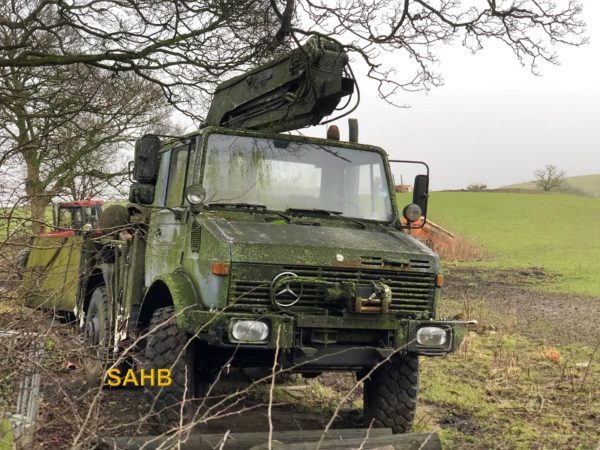
This machine, seen in Cheshire on the site of a logging business, may well not be in working order – but it is in its element. The crane above the cab sits with its operator’s seat on a central pivot on the rear bed. The three-pointed star has been moved to one side to accommodate a winch, just in case it needs to pull a tree out of a forest or pull itself out of a ditch. Its ground clearance makes a Land Rover look a little bit low-slung. This is a Unimog.
The Unimog was invented by German engineer Albert Friedrich, who worked for Daimler-Benz during World War II, designing aircraft engines. After the war Friedrich was unemployed; he had the idea of developing an agricultural vehicle similar to a tractor with a hitch and power take-offs, but with all-wheel drive and more offroad capability, able to operate saws in forests or harvesting machines in fields. He designed it with rear-wheel drive and switchable front-wheel drive, with equal-size wheels, to enable it to be driven on roads at higher speeds than standard farm tractors.
In November 1945 the US Military administration granted Friedrich a production order – meaning that they thought that it had no military purpose. In January 1946 Heinrich Rößler joined the development team and the first technical drawings were completed in March 1946. Rößler put a lot of emphasis on the functionality of the vehicle: for instance, the track measured 1,270mm, equal to two rows of potatoes. At this stage it was powered by a petrol engine.
In late autumn 1946 the vehicle was presented to experts and one of these, Hans Zabel, made the note “Universal-Motor-Gerät” (Universal-Motor-Device), which led to the acronym “Unimog”.
In 1948 Daimler-Benz were ready to mass-produce a new diesel engine, the OM 636, and Unimog decided to use this in their production vehicle. Gebr. Boehringer in Göppingen were selected to build the Unimog, but they were toolmakers rather than vehicle builders and could make no more than 50 per month. The Unimog was thus sold to its engine suppliers, Daimler-Benz, in October 1950. There have been many versions of the design but the one in our Snapshot is almost certainly a 427, first built in 1989 in the Heavy series.
The Unimog’s characteristic design element is its chassis: a flexible ladder frame with short overhangs, and coil-sprung beam portal axles, in which the centreline of the axle sits above the wheels’ centreline and drives them through reduction gearing. This gives high ground clearance without the need for big tyres. The axles can achieve a transverse angle of up to 30°, allowing the Unimog to drive over extremely uneven terrain, including boulders of one metre in height.
Unimogs are still made today and are used in every conceivable environment where off-road capability is essential. We would like to think that one day we shall return to this field in Cheshire and find that this Unimog is still there but has moved – and has mud on its tyres to prove it.







Leave a Comment